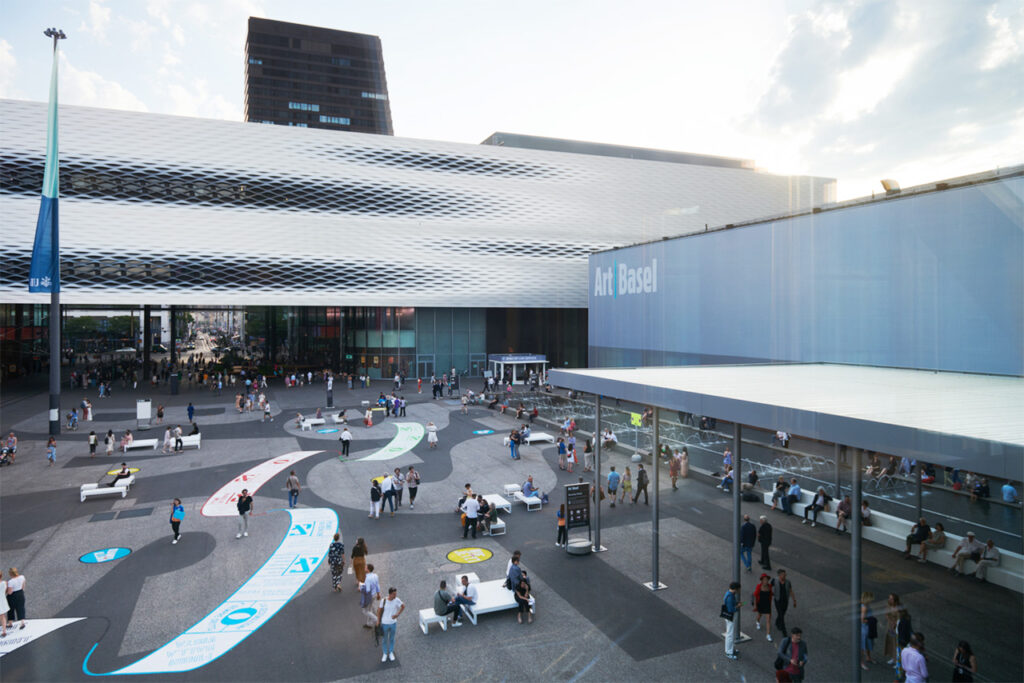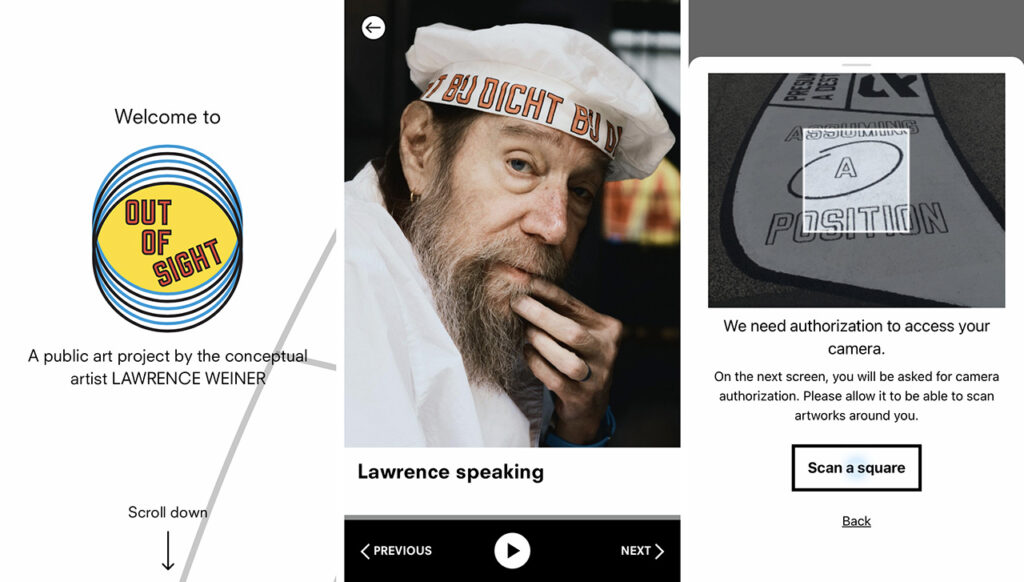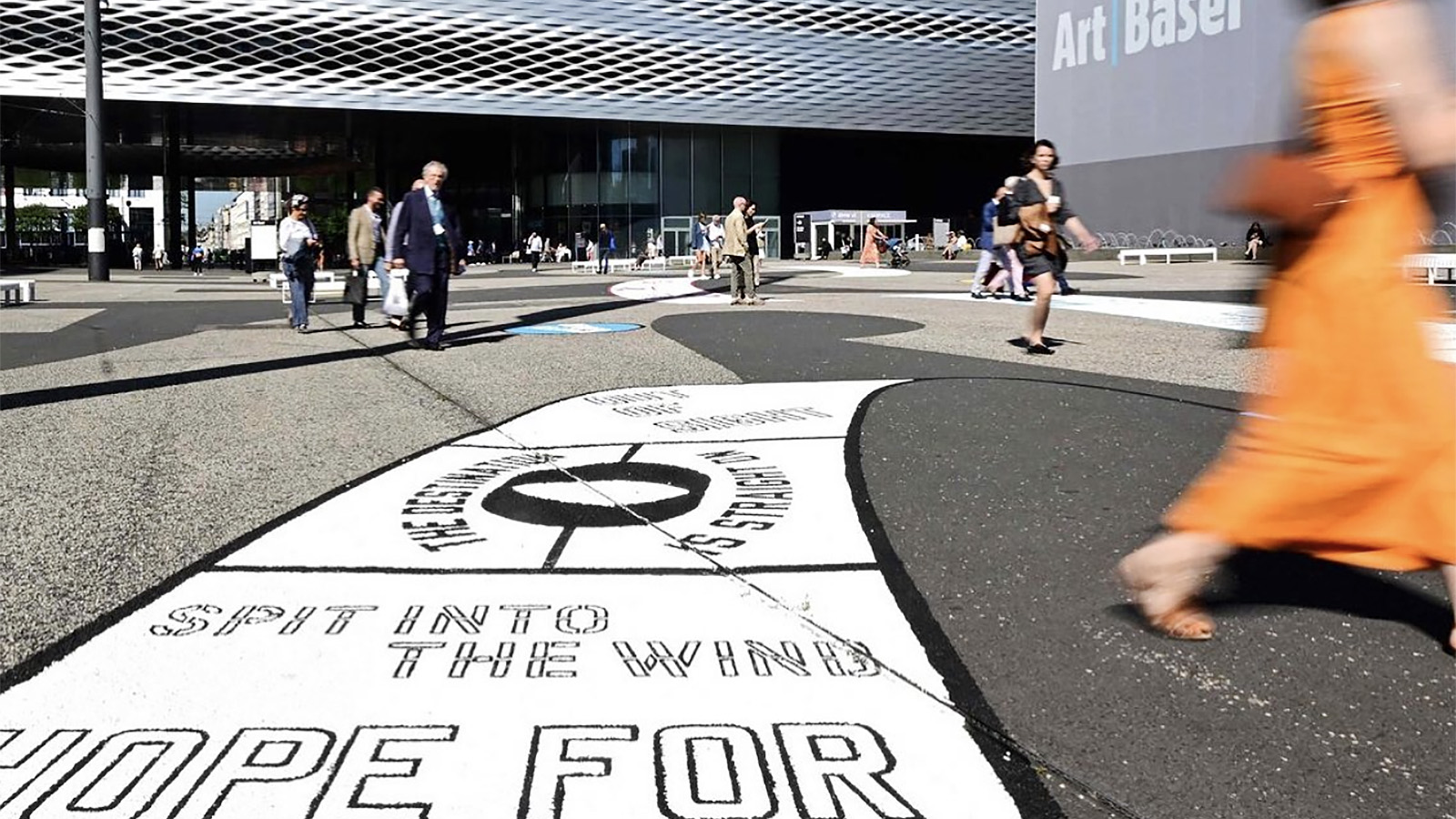Not for nothing has Lawrence Weiner’s “OUT OF SIGHT” traversed the world. Since 2016, the interactive project has made its way from Sydney to Miami, before enjoying its largest installation yet at Art Basel in June — all to ensure the artist’s “social sculpture” reaches the widest audience possible. “Accessibility is the goal,” says Zara Hoffman, Project Manager of See The Vision, Grab The Vision, the organization that programs the work. “The objective has always been for the most people to experience the project.”
To that end, “OUT OF SIGHT” has lately tapped the digital realm. Its opening at Art Basel also saw the unveiling of an accompanying web app, representing the first time that the work has been presented in digital form. Onsite visitors access the app by scanning the sections of the floor installation with their smartphone camera; they’ll then gain access to additional content, available in six languages and audio format, to deepen their engagement with “OUT OF SIGHT.” An offsite edition of the app is also due to be rolled out.

The “OUT OF SIGHT” installation at Art Basel in June was spread across the Messeplatz, representing the largest installation of Weiner’s work yet. Image: Courtesy Art Basel
The build of the app was overseen by French startup Livdeo using its GEED tool, which has also been deployed by other venues such as the Museum of Contemporary Art Australia for its mca.art web-based guide. A digital solution that facilitates the creation and distribution of multimedia content, GEED was launched with interactivity (hence its features such as image recognition and augmented reality) as much as accessibility and inclusivity in mind.
Of the latter, the service aims to deliver storytelling that’s multilingual and that doesn’t even require an internet connection for access — “experiences for general audiences without having to download a single app,” according to Ciprian Melian, Co-Founder and CEO of Livdeo. “We are pursuing this goal of bringing specific narrative layers and information to every single group of users [with different] multilingual preferences, preferred preferences, accessibility preferences, without having any constraint from a technology point of view,” he adds.

Built by Livdeo, the “OUT OF SIGHT” web app includes multimedia and onsite activations; an offsite edition of the app is due to be rolled out. Images: “OUT OF SIGHT” web app
It’s an offer that’s particularly attractive in a post-lockdown environment, where BYOD (Bring Your Own Device) has become de rigueur in museum-going, in turn motivating the cultural sector to more so deliver seamless digital experiences. In fact, the development of GEED, as well as Livdeo’s other products such as FeelTheArt, equally reflects the digital approaches by institutions and the demands of audiences. Here, Melian elaborates.
What prompted the development of GEED?
Back in 2015, when Livdeo started providing inclusive solutions, museums thought, “Hey, I need an app and to have my visitors download the app.” This was the marketing approach. But the reality is that if you don’t have the proper 4G connection in your venue in order to let your visitors download the app, your visitors won’t download the app. The reality versus the promise wasn’t too sexy. So we started working on the first pillar of GEED, which was the hardware to support experiences for general audiences without having to download a single app.
Why was it important that these experiences not require a download?
To be inclusive because every single visitor is not equal in terms of digital literacy or technology related to their device. We wanted to bring something which is very easy to get into and to engage with, without worrying about data connections or apps to download.

To access additional content, visitors simply scan sections of the floor installation using the web app. Image: Courtesy Art Basel
How does GEED approach the matter of engagement?
The starting point is always the communication onsite to let users know there is something to engage with. For example, at “OUT OF SIGHT” at Art Basel, there is a printed document in the venue. One of the other engagement elements is free exploration. [With “OUT OF SIGHT”], the camera triggers a free exploration, but some other users need or want to be guided. So we also have this mixed approach for users who say, “I want to start with a guided tour maybe, but if I’m in front of a specific point of interest or artwork that is not on my guided tour, I would love to have some information on that.” So it’s a mix between the guided and free exploration approaches, which is available for the museum teams to create.
What have been some of your key learnings over the past two years as museums digitally pivoted over COVID lockdowns?
During these two years, many experiences were conducted and created with VR or livestreaming with different success levels, but one pain point was not addressed. It is very difficult for an end user, having already done five Zooms at home, to get into a livestream or to pay for a VR tour. There have been trials here and there, but not a real, persistent approach to creating new revenue streams from digital content. That was key information for us to start working on tools and technology that serve an inclusive approach toward experiencing art and culture.
And what have you observed about the adoption of creative technologies by museums?
I think there is a real shift with what’s happening with AI technologies as a whole, in terms of image creation for the Dali tour, for example. Since October 2021, we’ve started working with AI models to see how the generated images and content might serve educational purposes or approaches. Besides image creation, AI can also be used for translation, which, from a multilingual and inclusion perspective, is a tool to be taken into consideration by museums.



